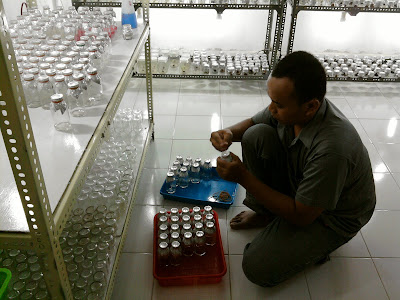Langkah pertama dalam pembuatan media MS adalah siapkan :
Bahan :
[1] Media MS kemasan untuk 1 liter media.
[2] Gula 30 gram
[3] Agar 8 gram
[4] Larutan aquadest
[5] Larutan NaOH 1 N
[6] Larutan HCl 1 N
[7] Larutan PPM
Alat :
[1] Gelas ukur ukuran 25 ml, 100 ml dan 1000 ml
[2] Backer glass ukuran 500 ml
[3] Erlenmeyer ukuran 1000 ml
[4] Pengaduk dari gelas
[5] Spet / jarum suntik ukuran 1 ml dan 5 ml
[6] Hot magnetic stirer
Cara kerja :
1 Pertama kali siapkan larutan aquadest sebanyak 250 ml diukur dengan gelas ukur ( gunakan menggunakan gelas ukur ukuran 25 ml dan 100 ml ) kemudian masukkan ke dalam backer glass ukuran 500 ml. Setelah siap lalu masukkan serbuk media MS siap pakai dan kemudian diaduk hingga larut semua ( untuk lebih cepatnya mengaduknya memakai hot magnetic stirer sehingga warna aquadest menjadi agak kekuningan.
2 Setelah media MS dilarutkan kemudian masukkan gula sebanyak 30 gram dan diaduk sampai larut semua dan agar lebih cepat digunakan hot magnetic stirer kalau perlu juga dipanaskan untuk mengaduknya.
3 Langkah selanjutnya pindahkan larutan ini ke dalam erlenmeyer ukuran 1000 ml kemudian tambahkan serbuk agar.
4 Selanjutnya tambahkan larutan aquadest sampai volume mencapai ukuran 1000 ml.
5 Setelah itu masak sampai mendidih dan agar larut semua.
6 Kemudian media yang sudah masak ini ditambahkan larutan PPM ( Plant Preservative Mixture ) atau ContaBlock dan hormon sesuai dengan kebutuhan.
PPM ( Plant Preservative Mixture )
ContaBlock
7 Selanjutnya ukur pH media dengan menggunakan pH stick yang elektric atau menggunakan kertas pH dan diukur pada pH 5,8 sd 6,0 ( karena saat autoclaf pH akan turun ± 0,2 sehingga setelah autoclaf diharapkan pH akan menjadi antara 5,6 sd 5,8 ).
8 Kemudia larutan media dibagi ke dalam botol-botol kultur yang sudah disiapkan dan setelah dimasukkan ke dalam botol kultur lalu botol ditutup dengan rapat menggunakan aluminium foil dan diberi label nama medianya.
9 Masukkan botol-botol kultur yang telah berisi media tersebut ke dalam autoclaf lalu autoclaf ditutup lalu autoclaf dipanaskan sampai pada suhu 121ºC dan tekanan 15 pound per inchi persegi selama 15 menit.
10 Setelah autoclaf selesai tunggu hingga tekanan menjadi 0 dan tunggu sampai autoclaf dingin, setelah dingin autoclaf bisa dibuka dan botol-botol yang berisi media bisa dikeluarkan dan diletakkan di ruang inkubasi pertama ( tempat penyimpanan media ).
11 Tunggu media dalam botol dingin dan menjadi padat dan karena menggunakan PPM maka media sekitar 3 jam atau setelah media dingin dan padat siap untuk digunakan untuk menanam eksplan.
Terima kasih dan semoga berhasil.


























































































































